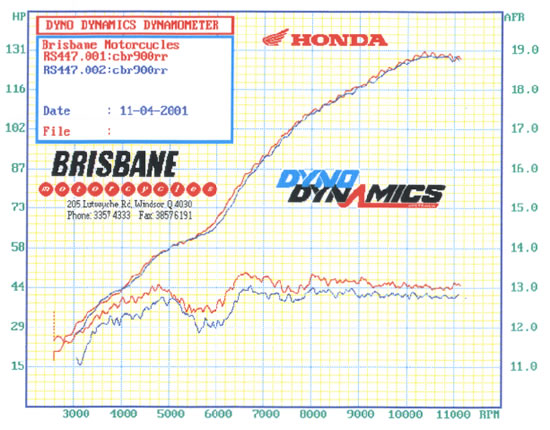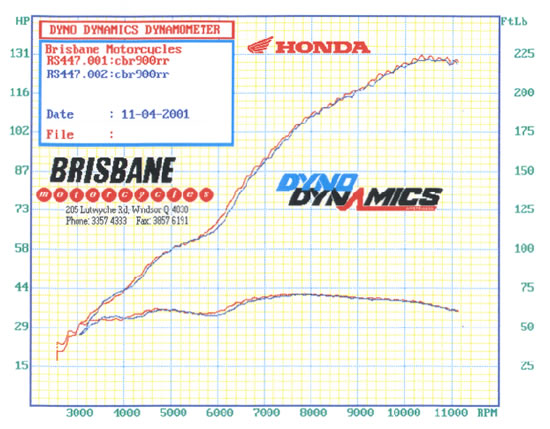
 |
|
HP
and Air / Fuel
|
 |
|
HP
and Torque
|
|
The dyno was playing up - these runs were done in top gear only - otherwise the graph would not show up on the machine, computer software no doubt....... Comments by Len Pattenden If you look at your dynograph, you'll see the first graph shows two hp and air/fuel comparisons (BTW, there's a little bit of chain-snatch there too, how old/how loose is your chain?). This shows the efficiency of combustion and highlights glitches in the metering. In the second you have measured hp and torque from two runs, which is pretty much a smoothing of the above graphs, with a max torque at just under 75Ft/Lb from about 7500 rpm (and on your bike it really kicks from about 5500, so from 5500 - 7500 you are riding with *pure torque*). Torque is the force your engine is applying (a twisting force), so if you have a spanner on a nut and it's 10 feet long and you apply 10 pounds of pressure it is a total of 100feet per pound (100ft/Lb). They use the diameter of the dyno wheel and with a known resistance of the wheel (std for each dyno so can't compare between dynos), they can calculate the force being applied as an expression of torque (the force it is applying to turn the dyno). HP is the measure of how something compares to the average horse (this is vintage units left over from the invention of the steam engine), and is a std that's accepted by most people. The power is measured by the rate of revolutions per second of the wheel of the dyno, so is dependant on the torque. HP = Torque x rpm/5252 (the number 5252 comes from the std work a horse can do). alternately, Torque = HP x 5252/rpm ..... So, when an engine is at 5252 rpm it's power and torque are equal (using these units of course). What is important now is the rates through the rev range. If the curves are steep down low, you have a good bottom end and the bike punches off the line. Not bad, your bike does by the look, but they've cut the bottom section. >machine playup From 3500 your bike winds it on steady, and the torque from early on gets it spinning up fast to 5500rpm. This is your midrange. At 6000rpm you see the sharp increase and so the rest of your torque comes in in one fat bolus, but by about 8000rpm it's all over as the spin of the engine is taking over. At 6000rpm the power curve goes into insanity mode, following the torque, and at 8000rpm, the torque is gone and so the power increase is not dependent on torque (it is but not so much), but on the spinning of the engine. This is the bite of the "top end". It goes faster above 8K, but doesn't pull per se, making it manageable at very high revs, whereas 6-8K is highside material and where you get your rush. So your "midrange" is a bit weak from about 3500- just over 5500, making it tractable in traffic, but quick, then at 6000-8000rpm it gets a second wind and "bang" everything is there at once. 6-8K represents a change of 10ft/Lb - in 2000 rpm. this is about 15% of your total torque in just 20% of your rev range, that's serious torque, especially when you see it is nearly 70% of the torque from 3500-8000rpm in 2000 rpm!!! In terms of Power, it's 39 ponies from 6-8k or 20% of your total power delivered in 20% of your rev range, ie it is proportional and linear, very hard, very fast and very smooth, but also hard to change lines when it comes on I imagine, but who gives a shit eh? It's overtaking you'll use this little boost, and it's here you'll eat other bikes between corners. |
|
|